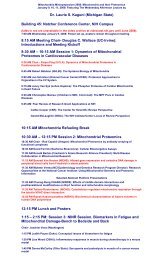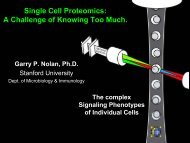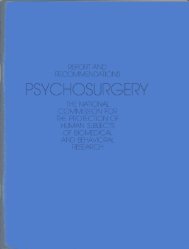RESEARCH ON THE FETUS - National Institutes of Health
RESEARCH ON THE FETUS - National Institutes of Health
RESEARCH ON THE FETUS - National Institutes of Health
You also want an ePaper? Increase the reach of your titles
YUMPU automatically turns print PDFs into web optimized ePapers that Google loves.
These criteria differ from those suggested by Dr. Behrman only by the addition<br />
<strong>of</strong> (2) and (3). Dr. Kass advised that the presence <strong>of</strong> any one <strong>of</strong> these functions<br />
is a sign that the fetus is alive (again in agreement with Dr. Behrman), and he<br />
further suggested that use <strong>of</strong> the EEG is unnecessary in making the diagnosis <strong>of</strong><br />
death. Finally, he recommended that the fetus in utero be considered alive until<br />
proved dead, and that the fetus being aborted be presumed alive until examination<br />
reveals it to be dead.<br />
A viable fetus was defined by Dr. Kass as one that has reached the stage<br />
<strong>of</strong> development at which it is able to sustain itself outside the mother's body.<br />
In suggesting criteria for fetal viability based on present technology, Dr. Kass<br />
supported use <strong>of</strong> essentially the same physiologic criteria as suggested by<br />
Dr. Behrman, but would not rely upon weight or gestational age to indicate the<br />
presence <strong>of</strong> these integrated functions in the delivered fetus. He suggested<br />
that the delivered fetus should be considered viable in the presence <strong>of</strong> all five<br />
<strong>of</strong> the functions listed above (the absence <strong>of</strong> which is definitive <strong>of</strong> death). Of<br />
these, respiratory activity is the sine qua non <strong>of</strong> viability. Following delivery<br />
<strong>of</strong> the fetus, adequate time should be allowed to assess the presence <strong>of</strong> life and<br />
determine viability before research involving the fetus can be considered. This<br />
evaluation should be made by the delivering obstetrician, and then only if he is<br />
not himself likely to be engaged in subsequent research involving the fetus.<br />
It is more difficult to determine whether the fetus in utero would be<br />
viable, if delivered, and, due to the possibility <strong>of</strong> error, Dr. Kass advised<br />
caution. He suggested that viability <strong>of</strong> the fetus in utero be evaluated<br />
according to gestational age. The fetus in utero is potentially viable before<br />
20 weeks gestational age, but nonviable if removed from the uterus. It should<br />
be considered viable after the age <strong>of</strong> 28 weeks. Accurate evaluation <strong>of</strong> the<br />
viability <strong>of</strong> a fetus in utero between 20 and 28 weeks gestational age is not<br />
possible; such a fetus should be presumed viable if a heartbeat is audible using<br />
a stethoscope. The fetus which is to be aborted before the heartbeat is audible<br />
should be regarded as potentially viable until the abortion procedure is actually<br />
in progress, after which it may be considered nonviable.<br />
59











